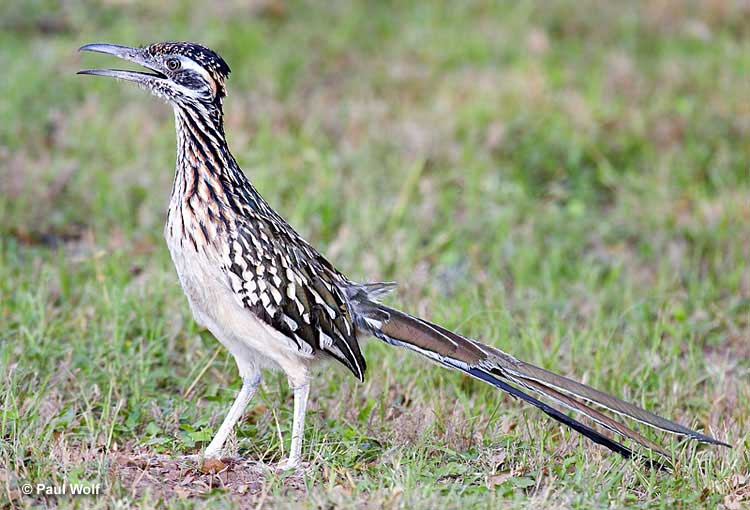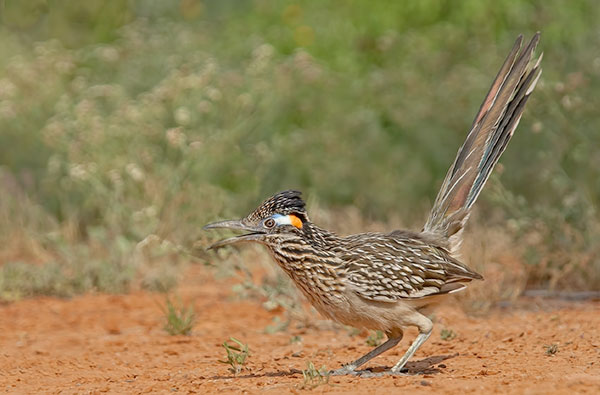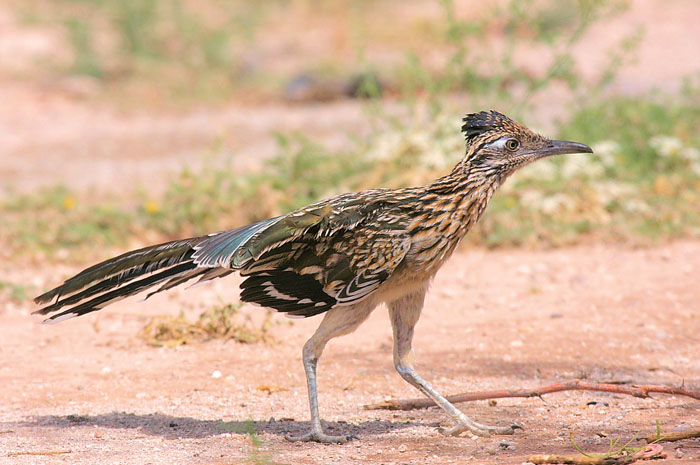
New Mexico is a western state with majestic mountain scenery, breathtaking deserts, and lots of birds! This gorgeous state has 121,591 square kilometers of alpine woodlands, brushlands, important wetlands, and 2.1 million residents.
New Mexico state bird is the Greater Roadrunner, one of the most unique and impressive birds of the state. True to its name, this terrestrial cuckoo is often seen running along roadsides and in other arid, brushy habitats.
On this page
New Mexico State Bird
The Greater Roadrunner became the state bird of New Mexico on March 16, 1949. On this date, the New Mexico legislature unanimously voted to choose this special species to represent their state.
As with many other states, the Federation of Women’s Clubs was encouraging New Mexico to choose an official state bird. They were also encouraging state to pick other state symbols. While some other states waivered between choosing birds like the Northern Cardinal, American Robin, or Western Meadowlark, the choice for New Mexico was an easy one.

Photograph © Alan Wilson.
No other bird represented the state better than a familiar species that had played an important role for people in New Mexico for centuries. Indigenous peoples had long admired the Greater Roadrunner and even regarded it as a species with supernatural powers.
European settlers also liked the roadrunner because they believed that if they became lost in the desert, the bird would lead you back to the right path. They were also pleased to learn that it liked to eat rattlesnakes and other venomous animals!
In modern New Mexico, Greater Roadrunners are still well-liked and appreciated birds. In 1969, the state created a mascot named Dusty Roadrunner. It has been used to educate and promote conservation and preservation of natural resources.
Fun Facts about Greater Roadrunners
- The Hopi culture have often used the symbol of a roadrunner track on their sacred Kachina figures. They believed that this “X” mark confuses evil spirits because it doesn’t show the direction in which the bird is traveling.
- Although the Warner Brothers’ cartoon character, “Roadrunner” is known for its incredible speed, in real life, it would lose a race with the Coyote. This canine species can run twice as fast as a Greater Roadrunner.
- The Greater Roadrunner isn’t the only roadrunner species. There is indeed a slightly smaller but very similar bird in Mexico and northern Central America known as the “Lesser Roadrunner”.
- To live in hot, arid environments, Greater Roadrunners have several adaptations. They save water by excreting salt from a gland in front of each eye, obtain water from the prey they eat, and they move the feathers on their chin to release excess heat.
- This species doesn’t have any problem eating venomous scorpions, lizards, and snakes. It even feeds on Horned Lizards but makes sure to swallow them head first so that the lizard’s “horns” don’t damage their digestive tract.
- The Greater Roadrunner is a smart bird that often becomes bold and tame around people that feed them. If they don’t perceive any threats, they won’t hesitate to enter yards to eat food left out for dogs and other pets. Some have even learned to peck on back doors to be fed!
- We often see this bird on the edges of quiet roads. They frequent roadside habitats to prey on mice, lizards, small birds, and other small animals attracted to seeds and other aspects of this edge habitat.
- The Greater Roadrunner is the largest member of the Cuckoo family. However, unlike several cuckoo species that lay eggs in nests of other birds, roadrunners use their own nest.
Identification
The Greater Roadrunner is a lanky bird with a long tail, short fluffy crest, and a grayish, fairly long beak. This species is around two feet long, has a 22 inch wingspan, and weighs 13 ounces.
Males tend to be slightly larger than females, but the difference in size is very small and hard to tell when seeing them in the field.
Another difference between male and female roadrunners is the color of the bare skin behind their eyes. Although both sexes have a dark orange spot at the end of their narrow skin patch, males have white just behind the eye while this area is blue in females and young birds.

Otherwise, both sexes and immature birds look the same. They are dark brown with buffy streaks above and on their chest, have buff spotting on their crown, dark eyes, and pale buff on their belly and undertail. This big ground bird doesn’t have any pattern on its long tail, and has dark, rounded wings.
Since there aren’t any other species in its North America range that look remotely like it, The Greater Roadrunner is very easy to recognize. We usually see this bird walking or running on the ground while it holds its tail and head low.
What do Greater Roadrunners eat?
Greater Roadrunners are omnivorous predators that eat all sorts of small animals along with some other food items. They feed on a lot of insects and larvae that they pick from shrubs, low trees, and from the ground. This species also uses its beak to turn over mud or other objects to find hidden bugs and other prey items.
In general, roadrunners do most of their foraging by standing on the ground and looking around for small lizards, small snakes, scorpions, and other prey. If they see something, they quickly run and snatch it with their beak. If they don’t spy any possible food, they run a short way and stop to look around again.

Greater Roadrunners are very opportunistic predators and won’t hesitate to go after mice, gophers, and other small rodents.
They will also eat just about any small bird they can catch! Roadrunners are notorious for waiting at feeders to ambush any unwary sparrows, cardinals, and hummingbirds.
They also take advantage of mist nets or other situations where they can easily catch small birds, and are important nest predators. When they catch a lizard or other small creature, roadrunners often smash the animal on the ground, over and over, until they can swallow it.
Call
Male Greater Roadrunners perch on a bush or post to sing a low-pitched, sad-sounding, cooing song of five or so notes. It slightly descends in pitch and sounds like, “woo..woo..woo..wooo..wooo..woooo”.
Females can make a barking sound that carries quite far and sounds a bit like a Coyote. Both sexes also make some other cooing, and whining sounds.
Behavior
Greater Roadrunners usually occur in pairs that defend a large territory and nest in a bush. This species often runs and stands in open areas with some brush, or in backyards where they can snatch pet food or attack birds at feeders and nest boxes.

Pairs can work together to catch food, especially to attack and kill fair-sized rattlesnakes! While one bird distracts the snake, its mate rushes in, grabs it by the head and then kills it by hitting it against a rock.
Frequently Asked Questions
How many bird species are in New Mexico?
There are more than 550 bird species in New Mexico. Not all of them are there year-round, but New Mexico is quite versatile when it comes to bird populations.
What is the rarest bird in New Mexico?
The rarest bird in New Mexico is the Eared Quetzal. Normally occurring in Mexico, in 2020, two were seen in the state for the first time. Other rare birds in New Mexico include the Rufous-necked Wood-Rail, Sungrebe, and European Golden-Plover.
What birds is New Mexico known for?
New Mexico is known for Greater Roadrunners and other desert species. The state also has rosy-finches in the mountains, and large numbers of Sandhill Cranes and other waterbirds that migrate to the state.
See more – most common birds of New Mexico

